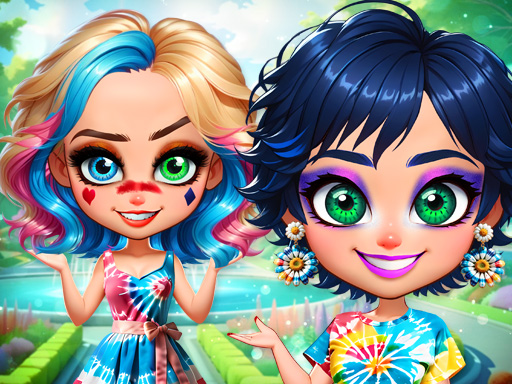Introduction
In recent years, the gaming industry has witnessed a remarkable transformation, particularly in the realm of DIY game design. One of the most striking trends is the explosion of color in game aesthetics. From vibrant palettes to intricate designs, color has become a critical element in creating immersive gaming experiences. This article explores the significance of color in DIY game design, its psychological impact, and how aspiring game developers can harness this trend to enhance their projects.
The Importance of Color in Game Design
Color is not merely a visual element; it plays a fundamental role in setting the mood, guiding player emotions, and influencing gameplay mechanics. In DIY game design, where developers often have the freedom to express their creativity, understanding color theory becomes essential.
Psychological Effects of Color
Different colors evoke various emotions and reactions. For instance:
- Red: Often associated with passion, danger, or urgency.
- Blue: Evokes calmness and tranquility.
- Yellow: Represents happiness and energy.
- Green: Symbolizes nature and growth.
- Purple: Conveys luxury and mystery.
By carefully selecting colors, game developers can manipulate player emotions, enhance storytelling, and create memorable experiences.
Color Theory Basics
Understanding the basics of color theory is vital for anyone venturing into DIY game design. Here are some key concepts:
Color Wheel
The color wheel is a visual representation of colors arranged according to their chromatic relationships. It consists of primary, secondary, and tertiary colors:
- Primary Colors: Red, blue, and yellow.
- Secondary Colors: Green, orange, and purple (created by mixing primary colors).
- Tertiary Colors: Result from mixing primary and secondary colors.
Color Harmony
Color harmony refers to the aesthetic arrangement of colors. Some common types of color harmony include:
- Complementary: Colors opposite each other on the color wheel (e.g., red and green).
- Analogous: Colors next to each other on the wheel (e.g., blue, blue-green, and green).
- Triadic: Three colors evenly spaced around the wheel (e.g., red, yellow, and blue).
The Explosion of Color in DIY Game Design
Trends in Color Use
The past decade has seen an explosion of color in DIY game design. Many games now feature bold, saturated colors that create a visually striking aesthetic. Titles like "Celeste," "Hyper Light Drifter," and "Gris" have become exemplars of this trend.
Case Study: "Celeste"
"Celeste," a platformer developed by Maddy Makes Games, showcases how color can enhance gameplay. Each level is characterized by distinct color palettes that reflect the environment and emotional themes. For instance:
- Bright Pink: Represents the protagonist's emotional struggles.
- Cool Blues and Greens: Evoke a sense of calm and tranquility.
Implementing Color in Your DIY Game
Choosing a Color Palette
Selecting an appropriate color palette is one of the first steps in DIY game design. Here are some strategies:
- Define Your Game’s Theme: Consider the mood and atmosphere you want to convey.
- Use Color Palette Generators: Tools like Adobe Color and Coolors can help you create harmonious palettes.
- Limit Your Palette: Using 3-5 colors can create a cohesive look and feel.
Bar Graph of Color Preferences in Game Design
| Color | Percentage Preference |
|---|---|
| Blue | 30% |
| Red | 25% |
| Green | 20% |
| Yellow | 15% |
| Purple | 10% |
Challenges in Using Color
While color can enhance gameplay, it can also pose challenges. Overly bright or clashing colors can lead to visual fatigue and distract players. Here are some considerations:
- Accessibility: Ensure color choices are accessible to players with color blindness. Use patterns or shapes alongside colors to convey information.
- Consistency: Maintain a consistent color scheme throughout your game to avoid disorienting players.
Tools for Color in Game Design
Many tools can assist DIY game developers in choosing and implementing colors effectively:
- Unity Asset Store: Offers assets and tools for color management.
- Aseprite: A pixel art tool that allows for precise color selection.
- GIMP: An open-source image editor for creating and manipulating color palettes.
The Future of Color in DIY Game Design
As technology evolves, the use of color in gaming is likely to become even more sophisticated. Emerging technologies like augmented reality (AR) and virtual reality (VR) will offer new avenues for color implementation, allowing for more immersive experiences.
Conclusion
The explosion of color in DIY game design is a testament to the creativity and innovation within the gaming community. By understanding color theory, leveraging tools, and considering the emotional impact of color, aspiring game developers can create engaging and memorable experiences. As the industry continues to evolve, the importance of color will only grow, making it an essential element in the toolkit of any DIY game designer.
Final Thoughts
Embrace the explosion of color in your DIY game design journey. Experiment with different palettes, learn from successful games, and don’t hesitate to push the boundaries of creativity. The vibrant world of gaming awaits your unique vision!







0 Post a Comment: